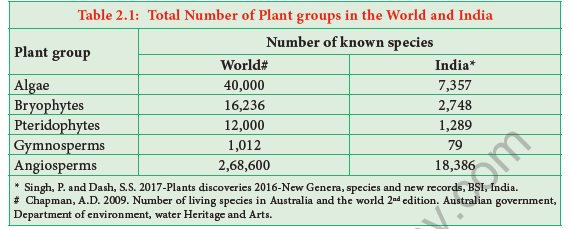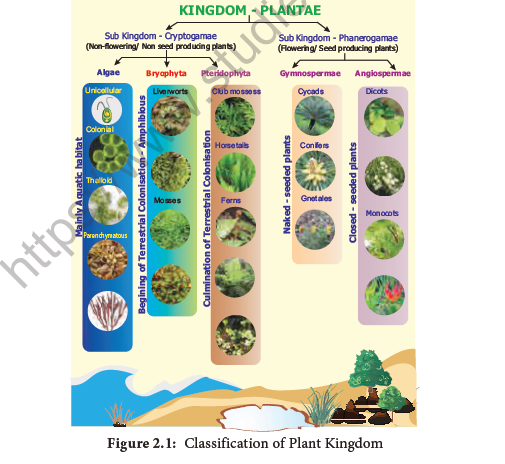Learning Objectives:-
The learner will be able to,
• Outline the classification of plants
• Illustrate the life cycles in plants
• Recognize the general characteristic features and reproduction of Algae
• Describe the structure, reproduction of Oedogonium and Chara
• Recognize the general characteristic features of Bryophytes
• Describe the structure, reproduction of Marchantia and Funaria
• Recognize the general characteristic features of Pteridophytes
• Describe the structure, reproduction of Selaginella and Adiantum
• Describe the general characteristic features of Gymnosperms
• Explain the structure, reproduction of Cycas and Pinus
• Recognize the salient features of Angiosperms
Chapter Outline
2.1 Classification of Plants
2.2 Life Cycle patterns in Plants
2.3 Algae
2.4 Bryophytes
2.5 Pteridophytes
2.6 Gymnosperms
2.7 Angiosperms

Traditionally organisms existing on the earth were classified into plants and animals based on nutrition, locomotion and presence or absence of cell wall. Bacteria, Fungi, Algae, Bryophytes, Pteridophytes, Gymnosperms and Angiosperms were included under plant group. Recently, with the aid of molecular characteristics the Bacteria and Fungi were segregated and placed under separate kingdoms. Botany is one of the oldest science in the world because its origin was from time immemorial as early men explored and identified plants for the needs of food, clothing, medicine, shelter etc., Plants are unique living entities as they are endowed with the power to harvest the light energy from the sun and to convert it to chemical energy in the form of food through the astounding reaction, photosynthesis. They not only supply nutrients to all living things on earth but sequester carbon-di-oxide during photosynthesis thus minimizing the effect of one of the major green house gases that increase the global temperature. Plants are diverse in nature, ranging from microscopic algae to macroscopic highly developed angiosperms. There are mysteries and wonders in the plant world in terms of size, shape, habit, habitat, reproduction etc., Although plants are all made up of cells there exists high diversity in form and structure (Table 2.1).

2.1 Classification of Plants
Classification widely accepted for plants now include Embryophyta which is divided into Bryophyta and Tracheophyta. The latter is further divided into Pteridophyta
and Spermatophyta (Gymnospermae and Angiospermae). An outline Classification of Plant Kingdom is given in Figure 2.1

2.2 Life Cycle Patterns in Plants
Alternation of Generation
Alternation of generation is common in all plants. Alternation of the haploid gametophytic phase (n) with diploid sporophytic phase (2n) during the life cycle is called alternation of generation. Following type of life cycles are found in plants (Figure 2.2).
Haplontic Life Cycle
Gametophytic phase is dominant, photosynthetic and independent, whereas sporophytic phase is represented by the zygote. Zygote undergoes meiosis to restore haploid condition. Example: Volvox, Spirogyra
Diplontic Life Cycle
Sporophytic phase (2n) is dominant,photosynthetic and independent. The gametophytic phase is represented by the single to few celled gametophyte.The gametes fuse to form Zygote which develops into Sporophyte. Example: Fucus, Gymnosperms and Angiosperms
Haplodiplontic Life Cycle
This type of life cycle is found in Bryophytes and pteridophytes which is intermediate between haplontic and diplontic type. Both the phases are multicellular. but they differ in their dominant phase.
Figure 2.2: Life cycle patterns in plants a) Haplontic, b) Diplontic, c) Haplo-diplontic

